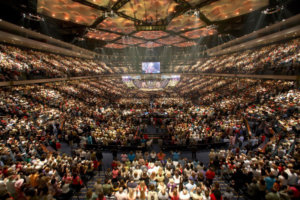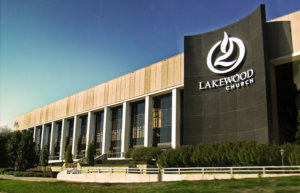Lakewood Church: Forewarned Is Forestalled?
Published on October 24, 2017, at 12:39 p.m.
by Maggie Schneider.
Sometimes, crises strike without warning. A sudden, unpredictable event creates a circumstance in which a company has to scramble to protect its reputation.
However, there are other times when a crisis is slow-moving and easy to get ahead of; but for some reason an organization makes a blunder — sometimes mishandling the situation or even outright ignoring it — and winds up scratching its head as to how it could have missed such an obvious danger.
This was the unfortunate case for one of the largest churches in the United States, Lakewood Church, in the wake of Hurricane Harvey.
Who Lakewood is
 Lakewood Church is a non-denominational Christian church in Houston that has a weekly attendance of anywhere from 35,000 to over 50,000. Unlike other churches with larger membership, such as Rick Warren’s Saddleback Church, Lakewood prefers to remain a church with a single location. So, when it needed more space, it bought the Compaq Center (where the Houston Rockets used to play) and renovated it into an over 16,000-seat church building.
Lakewood Church is a non-denominational Christian church in Houston that has a weekly attendance of anywhere from 35,000 to over 50,000. Unlike other churches with larger membership, such as Rick Warren’s Saddleback Church, Lakewood prefers to remain a church with a single location. So, when it needed more space, it bought the Compaq Center (where the Houston Rockets used to play) and renovated it into an over 16,000-seat church building.
Lakewood and its head pastor, Joel Osteen, have developed a brand based on helping people gain prosperity and be the best they can be. They regularly work with the Houston community and city officials.
Back in April, Lakewood partnered with the local district attorney and county commissioners for their “Make It Right” event to give people a chance to address outstanding warrants for minor offenses. They also provided legal counsel and even a resource fair with job training opportunities.
What Lakewood did
As Hurricane Harvey approached, the Lakewood communications team kept in touch with the city, ready to help wherever possible. The team was told to focus on becoming a distribution center for relief items. One thing they knew from the beginning was that they could not take people in as a shelter until after the storm had passed and the floodwaters had receded.

The former Compaq Center was not designed to be a shelter in hurricane conditions. One side of the edifice is mostly glass, and the lower levels are prone to flooding, necessitating 10-foot floodgates. The center would become an emergency shelter only if the shelters prepared by the city of Houston were full. Once the storm had passed, though, the building would be opened to evacuees and relief efforts.
What Lakewood neglected to do was tell anyone any of this. Not until there was already severe flooding did Lakewood begin announcing its efforts. Via Facebook and Twitter, the communications team directed people to the city shelters and announced that Lakewood was inaccessible. That was it.
What people saw
Not long after those Twitter and Facebook posts, other social media posts began surfacing. These posts seemed to show a church building unscathed and un-open to anyone who might need help. Christians and non-Christians alike quickly began to criticize Lakewood for being “closed.” They saw the church as hypocritical, turning its back on a city in need when surely this huge, rich church would have the resources to hold thousands.
How Lakewood responded
Lakewood Church was painfully slow at responding to these comments. Not until a day later did Don Iloff, the spokesperson for Lakewood, begin making statements to news media, trying to set the record straight, showing pictures after the fact of flooding around the building and saying that the church had never been closed. Curiously, Iloff began by reaching out to Christian media such as Faithwire and the Christian Post before speaking to the Houston Chronicle or national news.
Then, just as the church executives had planned, Lakewood began aiding relief efforts by taking in a few evacuees and becoming a distribution center for relief materials pouring into the city. Iloff explained to the news media that this had been Lakewood’s plan, but opening the doors immediately after acknowledging the controversy only made it seem like the church was guilty and scrambling to save face.
What Lakewood should have done
With 20/20 hindsight, it seems obvious that Lakewood had severe communication issues prior to and during the storm. A hurricane of Harvey’s magnitude is not a common occurrence, but it is an event that provides days of planning time. When a situation occurs that will affect an organization, it is vital that the organization begin constructing its narrative for dealing with that situation.
Before the hurricane hit, Lakewood should have released statements detailing the church’s plans to aid in hurricane recovery and listing the reasons that it would not be able to do anything until after the floodwaters had receded. This strategy may incur some initial criticism, but the transparency along with a promise of action would likely keep the negative comments to a minimum.
During the storm, the pictures of flooding in and around the Lakewood Church building should have been released immediately, continuing the narrative of what the organization was going through and what it was able to do. Instead of weakening the image of a large institution, these pictures would connect the church to the community, showing that it was just as “human” as the rest of the hurricane victims.
What now?
Lakewood is no stranger to controversy and negative press. It will be interesting to see how the church will attempt to rebuild its reputation as an organization dedicated to serving the people.




